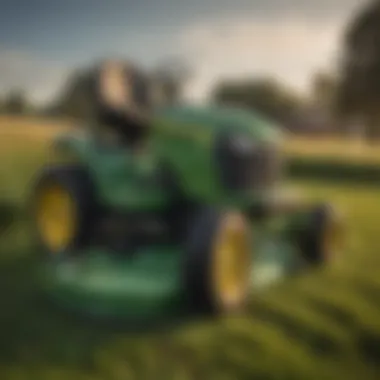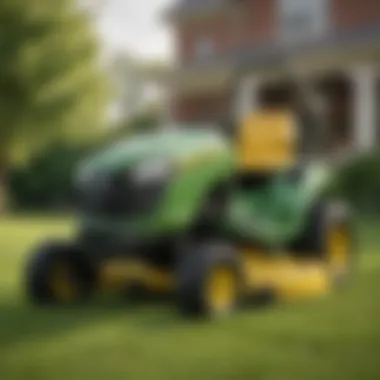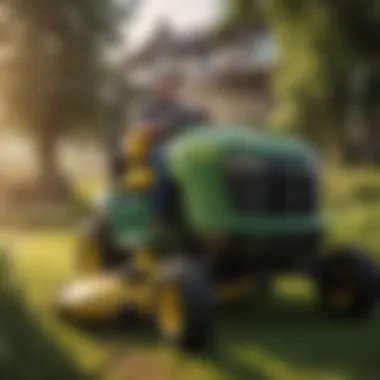Understanding John Deere Lawn Mowers with PTO


Intro
In the world of lawn care and agricultural practices, the John Deere brand has established a formidable reputation. Their lawn mowers equipped with Power Take-Off (PTO) systems stand as a testament to this legacy. Understanding how these machines function is crucial for farmers and landscaping enthusiasts alike. With PTO, users can power various equipment attachments, proving highly versatile for different tasks especially during busy seasons.
This article aims to explore the mechanics, advantages, and practical applications of John Deere lawn mowers with PTO. By delving into these concepts, readers can make informed decisions about purchasing and utilizing these machines effectively. This exploration includes insights on maintenance, comparisons to non-PTO models, as well as real-world applications, providing a holistic view that appeals to both novices and professionals.
Prolusion to John Deere Lawn Mowers
John Deere has long been synonymous with quality in agricultural machinery. Lawn mowers are one of their many offerings that reflect this tradition of excellence. Understanding John Deere lawn mowers is essential for any farmer or gardening enthusiast, as they combine innovative technology with user-friendly design. This section will shed light on key elements, benefits, and considerations specific to John Deere lawn mowers.
Brief History of John Deere
The John Deere Company originated in 1837 when John Deere, a blacksmith, designed a plow that was efficient for the tough soils of the Midwest. This innovation marked the beginning of a legacy that prioritized productivity in farming equipment. Over the decades, the company expanded its product line to include various types of machinery, including lawn care equipment. Today, John Deere is recognized not only for its durable tractors but also for reliable lawn mowers that fulfill diverse needs.
Overview of Lawn Mowers
Lawn mowers are essential tools for maintaining green spaces, whether residential yards or large agricultural fields. They come in various types and designs, from push mowers to riding ones. John Deere’s offerings include a range of mowers equipped with various features that improve efficiency and effectiveness.
- Types of Lawn Mowers: These can be divided into several categories based on power sources like gas, electric, or battery-operated mowers. Each type has its own strengths and weaknesses, catering to different preferences.
- Design Considerations: Effective lawn mowers must consider factors like cutting width, blade type, and ease of use. John Deere pays close attention to ergonomics and usability to ensure satisfaction for the operator.
In summary, the introduction to John Deere lawn mowers sets the context for deeper exploration into their specific features, particularly the Power Take-Off (PTO) systems that enhance their utility dramatically.
What is Power Take-Off (PTO)?
Understanding Power Take-Off (PTO) is vital for anyone looking to maximize the efficiency of a John Deere lawn mower. PTO systems facilitate the transfer of power from the engine of the mower to various attachments, allowing for a versatile range of applications. The significance of PTO lies not only in its operational capabilities but also in its role in improving productivity and versatility for both residential and commercial use. As lawn care becomes increasingly integral to agricultural practices, the importance of harnessing this technology cannot be overstated.
Definition of PTO
Power Take-Off, commonly known as PTO, is a mechanical device that allows the transfer of rotational power from the engine of a machine to an attachment or accessory. In the context of John Deere lawn mowers, this mechanism powers various types of equipment, such as mowers, tillers, and snow blowers. PTO systems come in different forms—each designed to serve distinct operational needs. By engaging the PTO, operators can seamlessly switch from one equipment function to another without the need for separate engines or systems.
PTO Mechanism Explained
The PTO mechanism generally consists of a rotating shaft connected to the drive system of the mower. When the engine runs, it provides continuous power to this shaft, which can be engaged or disengaged at will.
Here's how it typically works:
- Activation: The operator activates the PTO system, usually via a switch or lever located on the mower.
- Power Transfer: Once engaged, power flows from the engine to the attachment through the PTO shaft.
- Functionality: The attachment operates with the power supplied, enabling tasks such as mowing, mulching, or tilling.
PTO systems enhance versatility in lawn care and agriculture significantly. By allowing different implements to be connected and powered by one engine, it both saves fuel and increases efficiency. This operational simplicity is a reason why John Deere lawn mowers with PTO are favored by many users in agriculture and landscaping.
"PTO systems simplify the operation of various attachments, making them indispensable in modern lawn care and agricultural practices."
In summary, grasping the PTO concept is essential for users wanting to optimize their John Deere lawn mowers. Understanding its definition and mechanism paves the way for better management of lawn maintenance tasks and expands the utility of mowers in different environments.
Types of PTO Systems in Lawn Mowers
Understanding the types of Power Take-Off (PTO) systems in lawn mowers is essential for both efficiency and function. Different types of PTO systems bring about distinct advantages and are suited to specific tasks. Recognizing these differences aids users in making informed choices based on their needs. This article delves into two primary systems: Mechanical PTO and Hydraulic PTO.
Mechanical PTO
Mechanical PTO systems rely on a direct drive mechanism, usually powered by the lawn mower's engine. It transfers power through a belt and pulley system, providing a straightforward connection to the mower's attachments. One significant benefit is the simplicity of the design. Fewer components can mean less maintenance, and fewer points of failure. This is crucial for users who prioritize reliability in their equipment.


Additionally, Mechanical PTO is often less expensive than its hydraulic counterpart. For those with smaller properties or limited budgets, this system provides an economical option without sacrificing power. However, it may not offer the same level of control or adaptability that hydraulic systems do. As with anything, understanding the limitations is useful.
Pros and cons:
- Pros:
- Cons:
- Simplicity in design
- Cost-effective
- Reliable for smaller jobs
- Limited control over speed and power
- Might not be suitable for larger attachments
Hydraulic PTO
Hydraulic PTO systems utilize fluid pressure to operate, offering a more versatile approach compared to Mechanical PTO. The essence of hydraulic systems lies in their capacity to control power and speed more effectively. This can be particularly beneficial when using larger or multiple attachments.
A key advantage of Hydraulic PTO is the ability to vary the speed of attachments without manual adjustments. This capability leads to increased efficiency when working with varying tasks or conditions. Furthermore, hydraulic systems often feature more robust performance in demanding environments, like commercial or agricultural settings.
However, these systems come with their own set of challenges. They typically require more maintenance due to the complexity of hoses, fluids, and pumps. Users must also be mindful of potential leaks or pressure issues. Given these factors, understanding when and how to utilize hydraulic PTO effectively is essential for maximizing its benefits.
Pros and cons:
- Pros:
- Cons:
- Exceptional adaptability and control
- Suitable for larger, more demanding tasks
- Can handle multiple attachments simultaneously
- Higher maintenance needs
- Increased initial cost
Hydraulics may require familiarity, but the investment often pays off in enhanced productivity.
In summary, the choice between Mechanical and Hydraulic PTO systems depends on individual user needs and the nature of the tasks at hand. Understanding both types equips users to make better decisions regarding their lawn mowers. A informed choice leads to improved performance and satisfaction in their mowing experiences.
Advantages of Using PTO in Lawn Mowers
The inclusion of Power Take-Off (PTO) systems in lawn mowers is not merely a trend. It is a significant advancement that provides various advantages. Understanding these benefits helps users appreciate the operational capabilities that PTO offers. For both homeowners and professional landscapers, recognizing how PTO enhances mower performance can lead to more efficient and rewarding lawn care.
Increased Efficiency
One of the main advantages of using PTO in lawn mowers is the marked increase in efficiency. A PTO system enables the mower to transfer engine power directly to the attachments. This direct power transfer minimizes energy loss, ensuring that more power goes to the cutting blades or other attachments like sweepers and tillers. As a result, users can complete mowing tasks in less time, leading to a higher output of work per hour.
Additionally, equipped lawn mowers can often handle a variety of attachments with ease. For instance, using a PTO-driven brush hog or flail mower allows the operator to tackle dense grass and tough vegetation without the need for separate machines. This versatility not only saves time but also reduces the complexity of lawn care jobs.
Versatility of Attachments
The PTO system opens a world of possibilities when it comes to lawn care attachments. John Deere lawn mowers, fitted with PTO, can use various implements tailored for different tasks. This versatility is a compelling reason for both residential and commercial users to consider PTO-equipped models.
Attachments can vary from mowers and snow blowers to fertilizer spreaders and aerators. Each implement connects seamlessly via the PTO, enhancing the functionality of the mower beyond just cutting grass. For example, during the winter months, a snow blower attachment can be utilized, allowing the same mower to serve as a snow removal tool.
Moreover, this adaptability leads to cost efficiency. Instead of purchasing multiple machines for different tasks, a single John Deere lawn mower with PTO can perform various functions. Investing in such a system can lead to better equipment utilization.
"PTO-equipped mowers are not just for mowing; they are multi-functional tools that can adapt to many agricultural and landscape needs."
Applications of John Deere Lawn Mowers with PTO


Understanding the applications of John Deere lawn mowers equipped with Power Take-Off (PTO) systems is crucial. These machines are designed to handle a variety of tasks. Each application reveals how PTO contributes to efficiency and versatility in lawn care, commercial maintenance, and agricultural practices.
Residential Lawn Care
In residential settings, John Deere mowers with PTO provide homeowners the ability to efficiently maintain their lawns. The PTO system allows for the attachment of versatile tools such as grass cutters and leaf collectors. Users can easily switch attachments, adapting to seasonal needs. Keeping lawns well-maintained enhances aesthetics and property value. Moreover, precise cutting and customizable features lead to better overall lawn health.
Commercial Grounds Maintenance
For commercial grounds maintenance, the advantages increase significantly. Businesses that manage parks, golf courses, or corporate landscapes benefit from the robust capabilities of John Deere mowers. The PTO systems allow users to integrate various tools, including aerators and spreaders, into a single mower setup. This integration increases productivity. Moreover, the reliability of John Deere machinery ensures that high standards of landscape management can be met effectively within budget and time constraints.
Agricultural and Horticultural Uses
Finally, in terms of agricultural and horticultural applications, the PTO capability is a game changer. John Deere lawn mowers can attach implements such as tillers and seeders, making them suitable for farming tasks. This multifunctionality not only streamlines operations but also cuts down on the need for multiple machines. Farmers can manage their fields more efficiently, allowing them to adapt to various crops and changing agricultural demands.
"The versatility of PTO systems on John Deere mowers makes them an invaluable asset across various sectors, ensuring efficient use in residential, commercial, and agricultural contexts."
In summary, John Deere lawn mowers equipped with PTO systems are essential in numerous applications. They transform mundane tasks into manageable ones, while providing adaptability, reliability, and efficiency.
Comparing PTO and Non-PTO Lawn Mowers
The comparison between PTO and non-PTO lawn mowers is crucial for anyone considering their options in terms of efficiency and functionality. Understanding these differences can lead to more informed decisions, especially for agricultural farmers and enthusiasts. Both types have their strengths and weaknesses, and knowing what each brings to the table can influence productivity and satisfaction.
Performance Differences
When analyzing the performance of PTO lawn mowers versus non-PTO models, several critical factors emerge. PTO lawn mowers often exhibit greater power and efficiency. The PTO system enables the machine to transfer power directly from the engine to the attachments, which means the mower can handle a variety of tasks such as mowing, tilling, or even snow removal with less effort. This versatility significantly enhances productivity for those using John Deere equipment.
In contrast, non-PTO lawn mowers may struggle with heavy-duty tasks. They typically rely on a single function and lack the robust attachment capabilities. The ability to switch attachments with PTO systems offers substantial operational advantages. Users can approach different jobs without needing multiple machines, which optimizes both time and resources.
Moreover, PTO mowers usually operate more smoothly. As the power is utilized more effectively, there are fewer interruptions in operation. This improves the user experience, making lawn care less cumbersome and more enjoyable.
Cost Considerations
When it comes to cost, the differences between PTO and non-PTO models warrant careful examination. Generally, PTO systems come with a higher initial purchase price. The mechanism involved in PTO adds complexity and functionality, which can increase upfront investments. However, these costs can be justified through the efficiency and versatility that PTO mowers provide.
Operating costs also play a vital role in the decision-making process. PTO lawn mowers often require more maintenance due to their intricate systems. This maintenance can add to overall expenses, particularly if parts need replacement or repair. However, the labor and time saved when using a PTO mower often outweigh these additional costs, especially in commercial scenarios where productivity directly correlates with profitability.
On the other hand, non-PTO lawn mowers might seem more economical at first. Their simplicity generally leads to lower purchasing and maintenance costs. However, this can result in inefficiency in larger operations. Users of non-PTO models may find themselves needing multiple machines or experiencing slower task completion times, eventually offsetting the initial savings.
"The upfront investment in PTO systems often leads to greater long-term savings when considering efficiency and versatility."
Maintenance of Lawn Mowers with PTO
Maintaining John Deere lawn mowers equipped with Power Take-Off (PTO) systems is critical for ensuring optimal performance and longevity. These machines are designed for demanding tasks, often operating in tough conditions. Thus, proper care is not just recommended; it is essential. Neglecting maintenance can lead to increased wear and tear, costly repairs, and inefficient operation.
Regular maintenance practices can help avoid these issues and enhance the mower's effectiveness. It ensures all components function smoothly, reducing the risk of unexpected breakdowns. This reliability is particularly important for those relying on their lawn mowers for commercial or agricultural purposes. A well-maintained mower not only improves efficiency but also translates to better outcomes in the field.
Additionally, understanding how to troubleshoot common issues can save time and money in the long run. With correct maintenance and prompt resolution of any arising problems, users can enhance the usability and lifespan of their equipment.
Regular Maintenance Practices
Establishing a routine for regular maintenance is vital for a lawn mower's performance. Here are some essential practices to follow:


- Check the Oil: Regularly inspect and change the engine oil to keep the engine components lubricated and functioning optimally.
- Sharpen Blades: Keeping the blades sharp is crucial. Dull blades tear grass rather than cutting it cleanly, leading to an unhealthy lawn.
- Inspect Air Filter: A clean air filter allows the engine to breathe better and operate more efficiently. Replace or clean it regularly.
- Check Belts and Cables: Inspect belts for wear and tear. Replace any parts that show signs of fraying or loosening, as they can affect the mower's performance.
- Battery Care: If the mower is battery-operated, maintain the battery according to the manufacturer’s guidelines. Regularly check connections for rust or corrosion.
- Clean Undercarriage: Remove grass clippings and debris from the undercarriage to prevent buildup that can lead to rust or other maintenance issues.
Creating a checklist of these practices can help ensure nothing gets overlooked.
Regularly scheduled maintenance not only prolongs the life of your mower but also enhances its performance and efficiency.
Troubleshooting Common Issues
Even with diligent maintenance, issues may still arise. Recognizing these common issues early can help you address them before they escalate:
- Engine Won't Start: If the mower doesn’t start, check the fuel level, battery charge, and ignition switch. Ensure the fuel is fresh and that the fuel lines are clear.
- Uneven Cutting: This could result from dull blades, uneven tire pressure, or improper cutting height settings.
- Excessive Vibration or Noise: Inspection for loose parts or damaged components is necessary. Tighten any loose screws or bolts immediately.
- Overheating: This might indicate low oil levels or blockages in the cooling fins. Always check these first if overheating occurs.
Being aware of these common mechanical problems allows users to act quickly, leading to a better mowing experience. Regular checks and cautious observation can go a long way in preserving the functionality of lawn mowers with PTO systems.
Safety Considerations When Using PTO
The implementation of Power Take-Off (PTO) systems in John Deere lawn mowers brings numerous advantages, but it is crucial to recognize the inherent risks associated with this powerful tool. Safety considerations should always be a primary focus for operators and maintenance personnel. Understanding these safety protocols helps prevent accidents and ensures the reliable operation of lawn mowing equipment.
Emergency Procedures
In the event of an unforeseen incident while using a PTO-equipped lawn mower, it is essential to follow established emergency procedures. Here are some key steps to consider:
- Immediate Shutdown: If you notice any abnormalities, such as unusual noises or vibrations, stop the mower immediately. Locate the power switch and disengage the PTO.
- Assess the Situation: After shutting down the machine, evaluate the area for any potential hazards. Identify if there are any injuries or damage that needs addressing.
- Use the Manual: Refer to the mower’s operation manual for guidance on troubleshooting specific issues. This document will provide critical instructions on what to do next.
- Notify Personnel: If working in a team, ensure that others are aware of the situation. Communication helps in managing potential risks effectively.
- Call for Assistance: If the situation is beyond control, do not hesitate to contact emergency services or a qualified technician. It is better to seek help than to risk further complications.
Proper emergency procedures can significantly reduce the impact of mishaps and enhance overall safety.
Protective Gear Recommendations
Using protective gear is paramount when operating John Deere lawn mowers with PTO systems. It helps minimize the risk of injury and provides a layer of security during operation. Here are several essential protective items:
- Safety Goggles: Protect your eyes from debris and dust that may be ejected during mowing operations.
- Hearing Protection: PTO systems can produce loud noise levels, which can lead to hearing damage over time. Use ear plugs or earmuffs.
- Steel-Toed Boots: A strong pair of steel-toed boots can protect feet from heavy machinery accidents and improve traction.
- Gloves: Wear heavy-duty gloves to protect hands from sharp objects and equipment vulnerability.
- High-Visibility Clothing: Bright, reflective clothing can enhance your visibility, especially if you are working around other machinery or equipment.
Incorporating these safety measures ensures a safer working environment and promotes responsible use of the John Deere lawn mowers equipped with PTO. Following these guidelines fosters a culture of safety that benefits everyone involved in operations.
Future Trends in Lawn Mower Technology
Lawn mower technology is evolving swiftly. The need for efficiency and sustainability in lawn care drives these changes. Particularly, advancements in Power Take-Off (PTO) systems are crucial. This section highlights relevant trends in the industry and discusses the implications for both users and manufacturers.
Advancements in PTO Systems
Recent developments in PTO systems focus on enhancing usability and performance. These advancements aim to improve operational efficiency and minimize energy consumption.
- Electronic PTO Systems: Manufacturers like John Deere now offer electronic PTO systems. These systems provide more control over power usage and better integration with various attachments. This technology allows for smoother startups and improved response times when changing mower functions.
- Modular Attachments: New designs enable easy swapping of attachments. Users can connect different tools without needing to change underlying systems. This flexibility makes PTO-equipped mowers more adaptable to various landscaping tasks.
- Enhanced Durability: With the incorporation of stronger materials and better manufacturing techniques, modern PTO systems are more durable. This advancement leads to reduced maintenance costs and longer service life. Users gain assurance that they can depend on their equipment for various jobs.
- Smart Technology Integration: The integration of smart technology into lawn mowers is increasing. Systems now come equipped with sensors that monitor performance metrics in real time. This helps users optimize their use of power and adapt to changing field conditions.
Sustainability in Lawn Care
Sustainability is a significant concern in modern lawn care practices. As environmental awareness grows, incorporating sustainable methods into mowing becomes more critical. John Deere and other brands are working to design lawn mowers that focus on reducing environmental impact.
- Fuel Efficiency: New engines are designed to be more fuel-efficient. These engines consume less fuel for the same amount of work. Operators can maintain large lawns without exhausting resources.
- Electric and Hybrid Options: The shift towards electric and hybrid mowers is notable. These provide low-emission alternatives to traditional gas-powered machines. As battery technology improves, users can expect longer run times and quicker recharge periods.
- Biodegradable Attachments: Some manufacturers are exploring biodegradable materials for mower attachments. This aligns with the push toward zero waste in agriculture and landscaping.
- Ecosystem-Friendly Practices: Lawn mowers are now designed to enhance soil health and promote biodiversity. Features may include mulching capabilities that recycle grass clippings back into the lawn, which enriches the soil naturally.
By understanding these trends, users can make informed decisions about the equipment that best suits their needs.
End
Understanding John Deere lawn mowers with Power Take-Off (PTO) systems is essential for maximizing efficiency and productivity in both residential and commercial applications. Throughout this article, we explored the intricacies of PTO, highlighting its mechanisms and diverse benefits.
Summarizing Benefits and Applications
The advantages of using PTO in lawn mowers are numerous. These machines allow for enhanced versatility, enabling users to attach various implements such as lawn sweepers, tillers, and snow blowers. For farmers and landscapers, this adaptability can translate into significant time and cost savings. Furthermore, PTO systems provide increased operational efficiency, allowing for a seamless transition between different tasks. When properly maintained, John Deere lawn mowers with PTO systems can last many seasons, ensuring a strong return on investment.
Final Thoughts on Choosing the Right Equipment
Choosing the right lawn mower is imperative for achieving optimal results. Consideration must be given to the specific tasks at hand, the scale of the operation, and the type of terrain. John Deere offers a range of models adapted for various applications. Evaluate your needs carefully to select a machine that not only meets your current requirements but also offers flexibility for future tasks. Consulting expert reviews and guidelines can further assist in making an informed decision.



